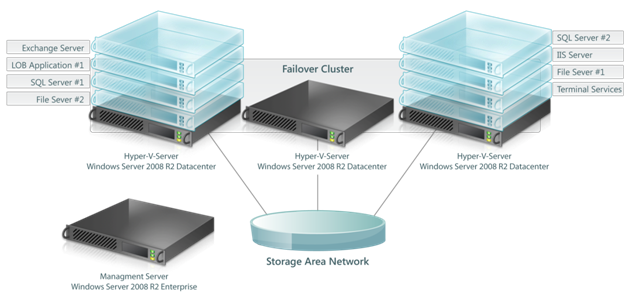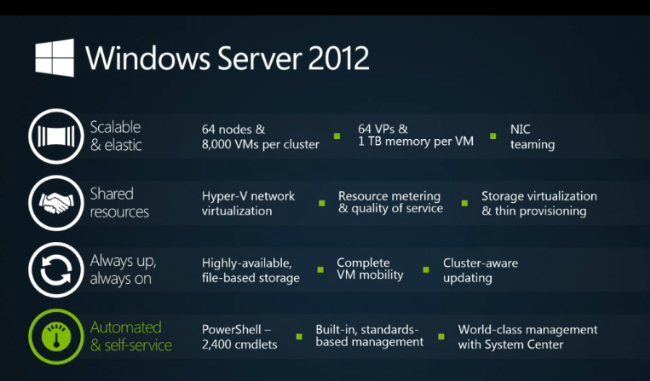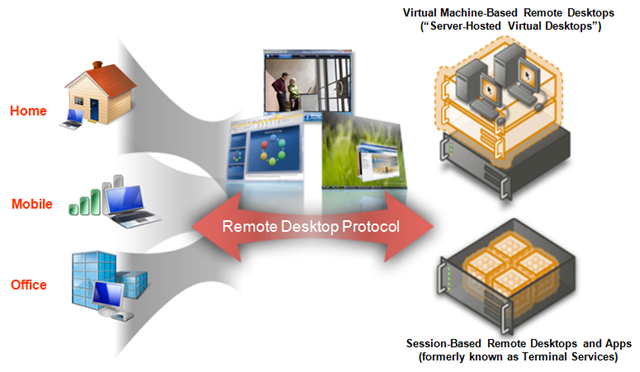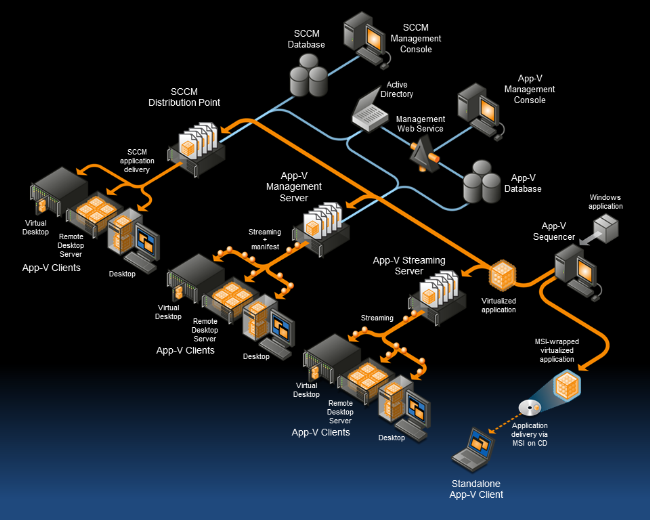
Microsoft Suite Virtualisation Solutions
- Hyper-V
-

Hyper-V provides a reliable virtualization platform that allows customers to virtualize their infrastructure and reduce costs. It has thin micro-kernelized hypervisor architecture, minimal attack surface and is available as a Server Core role.
Iconic specialise in the virtualisation stack and Microsoft Hyper-V is just one area of expertise.


System Center integrated management tools mean you can use a single set of tools to manage both your physical and virtual resources. And because it easily plugs into your IT infrastructure, you can leverage existing patching, provisioning, management and support tools, and processes. It’s a feature of Windows Server Operating System and it provides great value. Businesses can leverage the breadth of solutions from Microsoft partners, existing IT Pro skill sets, and comprehensive support from Microsoft.
Server virtualization, also known as hardware virtualization, is a hot topic in the IT world because of the potential for serious economic benefits. Server virtualization enables multiple operating systems to run on a single physical machine as virtual machines (VMs). With server virtualization, you can consolidate workloads of underutilized server machines onto a smaller number of fully utilized machines. Fewer physical machines can lead to reduced costs through lower hardware, energy, and management overhead, plus the creation of a more dynamic IT infrastructure.
Core Scenarios for Hyper-V
Server Consolidation
Businesses are under pressure to ease management and reduce costs while retaining and enhancing competitive advantages, such as flexibility, reliability, scalability, and security. The fundamental use of virtualization to help consolidate many servers on a single system while maintaining isolation helps address these demands. One of the main benefits of server consolidation is a lower total cost of ownership (TCO), not just from lowering hardware requirements but also from lower power, cooling, and management costs.
Businesses also benefit from server virtualization through infrastructure optimization, both from an asset utilization standpoint as well as the ability to balance workloads across different resources. Improved flexibility of the overall environment and the ability to freely integrate 32-bit and 64-bit workloads in the same environment is another benefit.
Business Continuity and Disaster Recovery
Business continuity is the ability to minimize both scheduled and unscheduled downtime. That includes time lost to routine functions, such as maintenance and backup, as well as unanticipated outages. Hyper-V includes powerful business continuity features, such as live backup and quick migration, enabling businesses to meet stringent uptime and response metrics.
Disaster recovery is a key component of business continuity. Natural disasters, malicious attacks, and even simple configuration problems like software conflicts can cripple services and applications until administrators resolve the problems and restore any backed up data. Leveraging the clustering capabilities of Windows Server, Hyper-V now provides support for disaster recovery (DR) within IT environments and across data centers, using geographically dispersed clustering capabilities. Rapid and reliable disaster and business recovery helps ensure minimal data loss and powerful remote management capabilities.
Testing and Development
Testing and development are frequently the first business functions to take advantage of virtualization technology. Using virtual machines, development staffs can create and test a wide variety of scenarios in a safe, self-contained environment that accurately approximates the operation of physical servers and clients. Hyper-V maximizes utilization of test hardware which can help reduce costs, improve life cycle management, and improve test coverage. With extensive guest OS support and checkpoint features, Hyper-V provides a great platform for your test and development environments.
Dynamic Data Center
Hyper-V, together with your existing system management solutions, such as Microsoft System Center, can help you realize the dynamic data center vision of providing self-managing dynamic systems and operational agility. With features like automated virtual machine reconfiguration, flexible resource control, and quick migration, you can create a dynamic IT environment that uses virtualization to not only respond to problems, but also to anticipate increased demands.
Cost-effective virtualization
Server virtualization is an effective method to improve resource utilization, increase availability, and improve agility within an organization’s infrastructure. Hyper-V Server provides a simple server virtualization solution for any size organization.
Improve scalability and performance
When consolidating servers, Hyper-V Server 2012 significantly increased scalability – both up and out – over previous versions. Now you can virtualize almost any workload.
Leverage your existing skills
IT professionals can easily leverage their existing knowledge and skills with Microsoft virtualization products, as well as the collective knowledge of the community, minimizing the learning curve. In addition, with Microsoft providing comprehensive support for Microsoft applications and heterogeneous guest operating systems, customers can virtualize with confidence and peace of mind.
- Remote Desktop Services
-

Remote Desktop Services accelerates and extends desktop and application deployments to any device, improving remote worker efficiency, while helping to keep critical intellectual property secure and simplify regulatory compliance. Remote Desktop Services enables both a virtual desktop infrastructure (VDI) and session-based desktops, allowing users to work anywhere.
Iconic specialise in the deployment of Remote Desktop Services and Virtual Infrastructures with many years of experience in this arena.

Most IT departments are currently facing the challenge of enabling worker productivity on a growing number of mobile devices in the workplace. Virtual Desktop Infrastructure (VDI) is a key technology that helps you to accommodate these new devices. By virtualizing resources, you can alleviate device compatibility and security issues while still delivering a consistent, familiar experience that enhances user productivity.
Microsoft is making it even easier to deploy and deliver virtual resources across workers’ devices.
VDI technologies in Windows Server offer easy access to a rich, full-fidelity Windows environment running in the datacenter, from virtually any device. Through Hyper-V and Remote Desktop Services, Microsoft offers three flexible VDI deployment options in a single solution:
- Pooled Desktops,
- Personal Desktops,
- Remote Desktop Sessions (formerly Terminal Services)
Windows Server delivers on significant enhancements for VDI.
Simplified Administration
One point of control to manage, configure, and deploy multiple virtual desktops and sessions, along with easier single-sign on administration.
Increased Value
Support for lower-cost storage hardware options like direct attached storage, eliminating the need to rely on expensive storage area networks.
Richer Experience
A superior user experience with support for low-bandwidth, high-latency wide area networks, and new support for USB and multi-touch devices.
With Windows Server, you get a complete VDI toolset for delivering flexible access to data and applications from virtually anywhere on popular devices, while also helping to maintain security and compliance.
- Application Virtualisation (App-V)
-

Microsoft Application Virtualization (App-V) transforms applications into centrally managed services that are never installed and don’t conflict with other applications.
IT professionals and end-users alike face challenges in today’s work environment. End-users speak many languages, are geographically disperse and may not be connected to corporate networks all times. IT must meet the needs if these users, and provide solutions that are fast, flexible and reliable. App-V can help with the challenges you face day to day and enable your business to be more flexible and responsive to changing needs.

Application Virtualization Made Easy
With App-V users simply click to launch applications that are available, anytime. They don’t have to wait for applications to install and reboot to start using new applications. Updates are a breeze! Moving to a new PC or a new version of Windows? Simply sign on to your new computer and your applications are available on demand.
With App-V it’s easy for IT to transform traditional applications into centrally managed, virtual applications. You can use powerful, but simple tools to create virtual applications. Create standard MSI-based packages that are ready to deploy with existing infrastructure, or take advantage of built-in deployment and management.
Flexible Management Built right in
App-V enables IT to use the built-in management to stream applications to users on demand and allow users to update applications without disconnecting or rebooting. Assign applications to users using Active Directory, and retire applications quickly by removing the assignment – no uninstall required. You can also track application licensing and meter usage.
App-V integrates with System Center Configuration Manager, so you can manage virtual and physical applications, along with hardware and software inventory, operating system and patch deployment, and more.
Proven Technology, Real Business Results
App-V is the mature and proven application virtualization solution.
If you would like to find out more about how Iconic IT can help your business with our consultancy services then please contact us today on 0330 088 3338.
